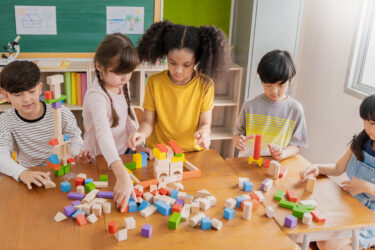When I was 11, kids in my class steered clear of Quentin Tacker, the sixth-grade bully. Quentin was notorious for being the meanest kid at school. His targets often had their lunch money stolen, got stuffed in lockers, beaten up, threatened, intimidated, you name it. In retrospect, it was really quite amazing how one kid could instill fear and terror in so many.
 Quentin was the textbook definition of a bully – one who torments others through physical assault, verbal harassment or other subtle methods of coercion. So, what is it that makes someone a bully?
Quentin was the textbook definition of a bully – one who torments others through physical assault, verbal harassment or other subtle methods of coercion. So, what is it that makes someone a bully?
Aimee Lyst, Ph.D., a licensed clinical psychologist and certified school psychologist with Pediatric Associates of Franklin, says most bullies usually have a few consistent characteristics. They may be impulsive, have dominant personalities, get easily frustrated, have difficulty following the rules and view violence in a positive light. Self-esteem, or the lack thereof, also plays a part.
“I think most of these kids are lacking in self-esteem,” says Lyst. “What is more likely is that these children are exhibiting the modeling they learn at home or are using the coping resources they have to get along. In some cases, bullies can be among the most popular kids in their class. This is scary when you think that the bullying behavior is actually reinforced by other children,” she adds.
When it comes to bullying, it’s usually a matter of nurture not nature. “There are some common family factors that include a lack of parental warmth and lack of supervision,” says Lyst. “Parents play a huge role in shaping and modeling their child’s behaviors. Increasing parental involvement and supervision as well as parental warmth would have an insulating effect against future bullying behavior.” Lyst adds that it’s important for parents to start laying the groundwork for appropriate social behaviors as early as preschool.
So, if you have a kid who bullies, what can you do about it? Most bully intervention programs occur in the schools, since that’s where the behavior typically takes place. But parents can and need to get involved as well. Lyst says parents should have open communication with their school and enforce consistent consequences when they receive reports of their child bullying at school. “Parents should enforce clear and concise behavioral guidelines and reward children for positive, inclusive behavior. Furthermore, parents should seek assistance from the school’s principal, teachers and counselors if concerns regarding their child’s or another child’s behavior arises.
Who Gets Bullied?
What is within someone that makes them automatically a target of bullies? Is it the clothes? The hair? Not likely. You can change all of that, and some children will always be targets. But, why? Seth Scholer, M.D., an associate professor of pediatrics at Monroe Carell Jr. Children’s Hospital at Vanderbilt, says most children who are bullied tend to share similar characteristics. “Most fall into the submissive group,” says Scholer. “Children who are bullied may be quiet and sensitive or have poor self-confidence.” Additionally, boys who are bullied may not like to fight and may be physically weaker than their peers. “A small proportion of children who are bullied are even provocative,” says Scholer. “They can have hot tempers, they may be disliked by adults, or they may try to bully weaker students.â€
What to Do
If your child gets bullied, knowing how to handle it is the key. Often children who are being bullied are afraid to say anything to anyone for fear of aggravating the situation even further. Authorities may offer assistance, but enlisting the help may create more problems. Parents shouldn’t let those fears stop them from doing something, though. “Pursue the issue,” says Scholer. “Contact the school or other place, and plan an extended approach, not just a one-time fix.” If possible, keep your school discussions low-profile so as to not create more problems. Schools are responsible for creating safe environments and should be aware of any bullying activity that goes on. Additionally, there should be clear limits for what’s acceptable behavior and what’s not. “Non-physical consequences should be applied if rules are broken,” says Scholer.
At Home
There are several things that parents can and should do if their children are being bullied. Take steps to nurture more self-confidence in the child and enroll him in groups – sports, music, etc. – with other children his age. Additionally, Scholer suggests parents role play with their children what to do if they’re bullied. Strategies include firm words and a keeping a brave face. Lastly, says Scholer, “Create a warm, nurturing environment at home. Try to spend at least 15 – 30 minutes of individual time with your child every day. If the situation is dealt with in an appropriate manner, it helps both the victim and the bully.â€
Chad Young is managing editor for this publication.
Could Your Child Be an Online Bully?
Before you answer, “Not my kid!,” think about it. Almost a quarter of all teens and pre-teens say they have been bullied online. Somebody is sending vicious IMs, hijacking screen names and posting cruel quizzes, humiliating photos and nasty comments on Web sites.
Even if it’s not your kid, it’s probably someone she knows. The Internet has, unfortunately, made bullying an equal opportunity enterprise. Kids no longer have to be the biggest boy or the toughest girl to be a bully. Online, anyone with a computer or cellphone can make other kids deeply miserable.
Cyberbullies come in four flavors according to Parry Aftab, an Internet lawyer who started the Web site www.stopcyberbullying.org. The “Power Hungry” resemble traditional bullies. They abuse people to prove they are tough and strong, often because they have doubts about whether they really are. “Mean Girls” are also a familiar type. Their weapon is malicious gossip distributed more widely and quickly through IM and text messaging. “Vengeful Angels” are kids who might never have been bullies in the past.
They start out wanting to right wrongs against themselves or friends, but their counter attacks become so ruthless that they too become bullies. Finally, “Inadvertent Cyberbullies” simply don’t think about the harm they are causing. If the abuse were happening in person, they might get a queasy feeling, but online, where they can’t see the reaction of victims, they get swept along because “everyone seems to be doing it.â€
The first step in combating online bullying is to be sure your child knows what it is. Be explicit about behavior you consider unacceptable. Make it clear that kids should never send cruel or threatening messages, post on a blog or Web site that ridicules other people, use another person’s screen name to send messages or forward personal information including photographs without the owner’s permission.
If you find your child has been involved in cyberbullying, take it seriously and think carefully about the consequences you impose. Loss of computer or cellphone privileges is an obvious choice. Remember, however, that your ultimate goal is to instill empathy not further alienate a child who may already be feeling angry and insecure.
Carolyn Jabs is a former contributing editor of Family PC and mother to three computer-savvy kids. Other columns can be seen at growing-up-online.com.
If you’re interested in learning more about bullying, take part in “Turning Bullies Into Buddies,” a seminar taking place at the Hilton Suites Downtown on Saturday, May 19 from 8 a.m. – 3:30 p.m. Register online at www.crosscountryeducation.com.
play nice
The Monroe Carell Jr. Children’s Hospital at Vanderbilt recently released the second edition of a CD-ROM, Play Nicely, that teaches adults who work or live with children how to manage early childhood aggression in ages 1 – 7. The program works on the assumption that if aggressive behavior isn’t handled appropriately in the early childhood years, it can lead to a violent lifestyle in later life. Play Nicely can be purchased for $19.95 at www.playnicely.org or by calling 343-2430.




